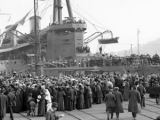What happened that day?
See historic events for any day of the year by entering the date below. Why not try your birthday?
Kiwi of the Week
Today in History

1913 HMS New Zealand begins tour of NZ
In 1909 Prime Minister Sir Joseph Ward announced that New Zealand would fund the construction of a battleship to be gifted to the Royal Navy. Construction of HMS New Zealand cost £1.7 million ($231 million in 2007). With 26 guns and 800 crew, the ship was commissioned for service in November 1912.
HMS New Zealand arrived in Wellington on 12 April 1913 as part of a 10-week tour, during which time an estimated 500,000 New Zealanders inspected their gift to Mother England. In Auckland, 10 sailors deserted and in Dunedin sightseers had to be ferried out to the heads because the ship was too large for the harbour.
The ship’s captain was presented with a piu piu (flax skirt) and greenstone tiki (pendant) which was intended to ward off evil. Captain Green wore both items during the Battle of Jutland in May 1916, when the ship escaped significant damage and casualties. This action earned HMS New Zealand a reputation as a lucky ship, which some attributed to the piu piu and tiki.
In 1919, when Admiral Jellicoe took a Royal Navy fleet on another tour of the dominions to give a report on their defences, he chose HMS New Zealand as his flagship. In New Zealand, crowds once more flocked to visit the ship. More than a third of the country’s population of 1.1 million people went aboard during the 11 weeks it was here.
In 1922 HMS New Zealand was decommissioned and sold for scrap. New Zealand did not finish paying for the vessel until 1944.














